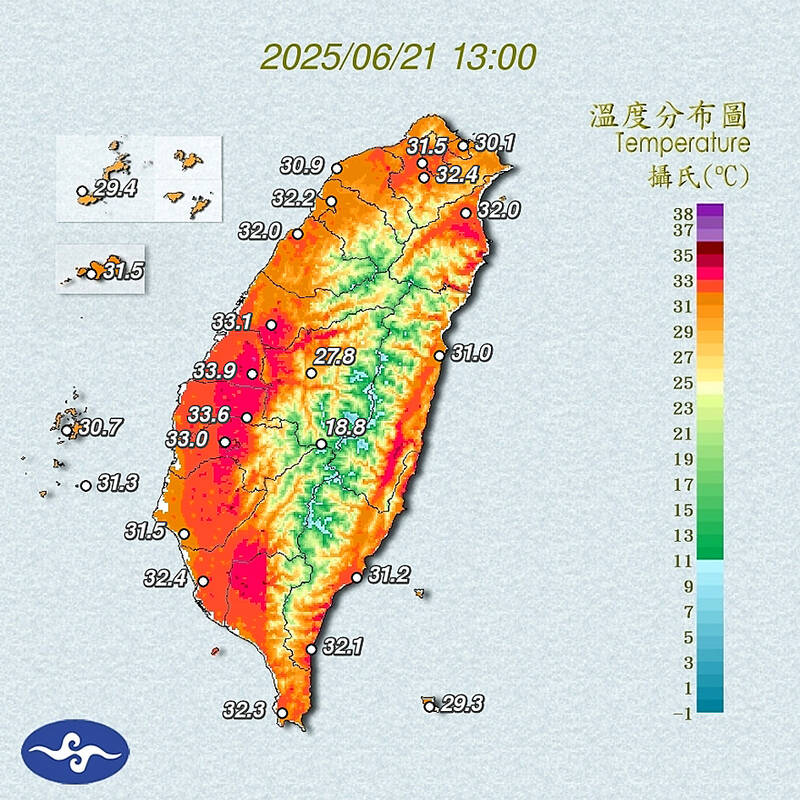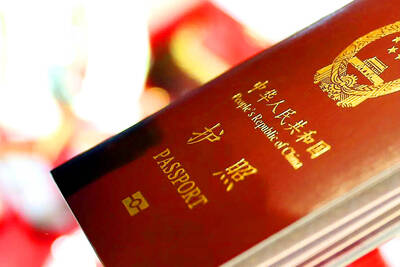The Central Weather Administration (CWA) is considering amending the Meteorological Act (氣象法) to classify “high temperatures” as “hazardous weather,” providing a legal basis for work or school closures due to extreme heat.
CWA Administrator Lu Kuo-chen (呂國臣) yesterday said the agency plans to submit the proposed amendments to the Executive Yuan for review in the fourth quarter this year.
The CWA has been monitoring high-temperature trends for an extended period, and the agency contributes scientific data to the recently established High Temperature Response Alliance led by the Ministry of Environment, Lu said.

Photo: Screen grab from the Central Weather Administration
The data include temperature, humidity, radiation intensity and ambient wind, which help government agencies develop effective high-temperature response strategies, he said.
The CWA is also responsible for issuing weather warnings, and would cooperate with other government agencies, such as the Health Promotion Administration to prevent heat-related workplace hazards, the Ministry of Agriculture to formulate responsive strategies for crops and fisheries, and other agencies involved in energy adaptation policies, he added.
The CWA issues heat warnings using a color-coded system — “red,” “orange” and “yellow” — to indicate high temperatures and their expected duration. However, as the frequency of high-temperature days increases, the agency is considering amending the law to add “high temperatures” to the list of “hazardous weather,” Lu said.

Photo: CNA
Regarding the possibility of closing work or school on high-temperature days, similar to typhoon days, Lu said that the legal basis for declaring “typhoon days” is the Operation Regulations on the Suspension of Offices and Classes in Times of Natural Disasters (天然災害停止上班及上課作業辦法).
If the Meteorological Act is amended to list high temperatures as “hazardous weather,” it can be categorized as “other natural disasters,” allowing local government heads to declare work or school suspensions during high-temperature events, should they determine risks such as transportation disruptions, power outages or potential dangers to public safety, he said.
Specialists said that while listing high temperatures as “hazardous weather” can enhance the warning system’s effectiveness, closing work or schools due to heat might not be necessary, as alternative measures, such as adjusting work hours or implementing flexible responses, might be more suitable.
WeatherRisk Co environmental resources director Chia Hsing-hsing (賈新興) said that the long-term trend of global warming suggests there would be an increasing number of high-temperature days, citing warnings from the UN’s International Labour Organization and public health studies about the potential negative impacts of high temperatures on economic productivity, infrastructure and public health.
Listing high temperatures as “hazardous weather” is necessary, he said, adding that the government should also have a cross-ministerial cooperation mechanism to address the impacts of high temperatures on health, infrastructure and labor productivity.
As to whether work or schools should be closed during high temperatures, Chia said the nature and duration of high temperatures are not the same as typhoons, as the former usually only occur during the few hours around noon, while the latter is an extreme weather event which can last for half a day or longer.
Other measures should be considered first, such as adjusting work hours to avoid working outdoors at peak hours, he added.
National Central University adjunct associate professor of atmospheric sciences Daniel Wu (吳德榮) said that listing high temperatures as “hazardous weather” could raise awareness of the associated risks, such as enabling farmers to take precautions against crop damage from foehn winds.
However, suspending work or school due to high temperatures involves various other factors, making it a broader issue that requires further discussion across sectors, he said.
The CWA yesterday issued a yellow-level heat warning for Taipei and Tainan, and an orange-level alert for New Taipei City, Kaohsiung and Pingtung County.
The yellow warning indicates that daily maximum temperatures could reach or exceed 36°C, while the orange warning means temperatures have reached at least 36°C for three consecutive days.
New Taipei City, Kaohsiung and Pingtung County have been under orange-level alert for three days.
Additional reporting by Lo Hsin-chen and Huang Tzu-yang

The Ministry of the Interior (MOI) is to tighten rules for candidates running for public office, requiring them to declare that they do not hold a Chinese household registration or passport, and that they possess no other foreign citizenship. The requirement was set out in a draft amendment to the Enforcement Rules of the Public Officials Election and Recall Act (公職人員選舉罷免法 ) released by the ministry on Thursday. Under the proposal, candidates would need to make the declaration when submitting their registration forms, which would be published in the official election bulletin. The move follows the removal of several elected officials who were

FOUR DESIGNATED AREAS: Notices were issued for live-fire exercises in waters south and northwest of Penghu, northeast of Keelung and west of Kaohsiung, they said The military is planning three major annual exercises across the army, navy and air force this month, with the navy’s “Hai Chiang” (海強, “Sea Strong”) drills running from today through Thursday, the Ministry of National Defense said yesterday. The Hai Chiang exercise, which is to take place in waters surrounding Taiwan, would feature P-3C Orion maritime patrol aircraft and S-70C anti-submarine helicopters, the ministry said, adding that the drills aim to bolster the nation’s offshore defensive capabilities. China has intensified military and psychological pressure against Taiwan, repeatedly sending warplanes and vessels into areas near the nation’s air defense identification zone and across

SENATE RECOMMENDATION: The National Defense Authorization Act encourages the US secretary of defense to invite Taiwan’s navy to participate in the exercises in Hawaii The US Senate on Thursday last week passed the National Defense Authorization Act (NDAA) for Fiscal Year 2026, which strongly encourages the US secretary of defense to invite Taiwan’s naval forces to participate in the Rim of the Pacific (RIMPAC) exercise, as well as allocating military aid of US$1 billion for Taiwan. The bill, which authorizes appropriations for the military activities of the US Department of Defense, military construction and other purposes, passed with 77 votes in support and 20 against. While the NDAA authorizes about US$925 billion of defense spending, the Central News Agency yesterday reported that an aide of US

NATIONAL DAY: The ‘Taiwan Dome’ would form the centerpiece of new efforts to bolster air defense and be modeled after Israel’s ‘Iron Dome,’ sources said President William Lai (賴清德) yesterday pledged to strengthen the nation’s air defense capabilities and build a “T-Dome” system to create a safety net against growing military threats from China. “We will accelerate our building of the T-Dome, establish a rigorous air defense system in Taiwan with multi-layered defense, high-level detection and effective interception, and weave a safety net for Taiwan to protect the lives and property of citizens,” he said in his National Day address. In his keynote address marking the Republic of China’s (ROC) 114th anniversary, Lai said the lessons of World War II have taught nations worldwide “to ensure that